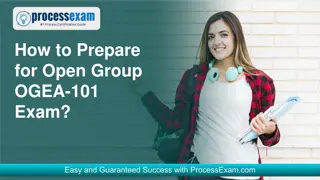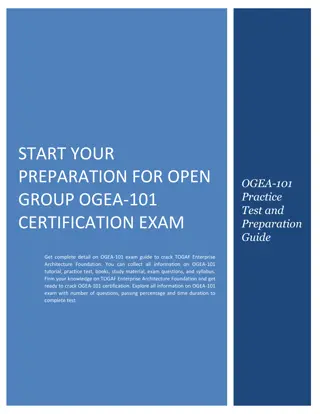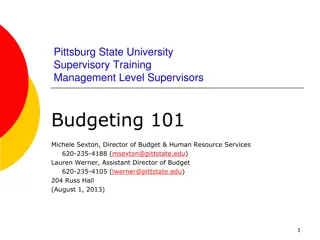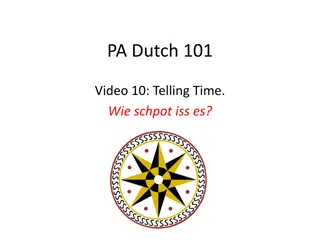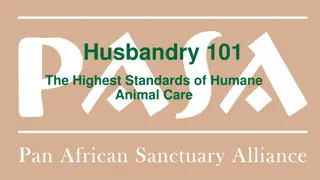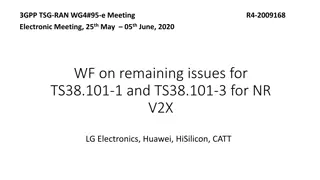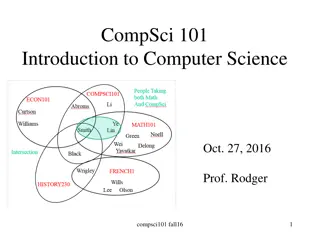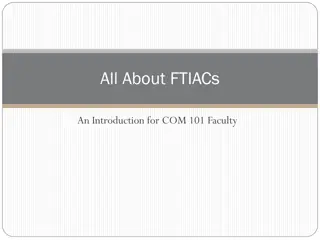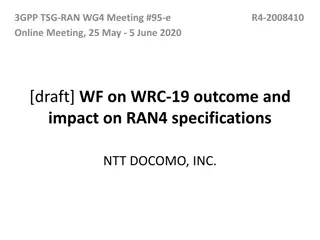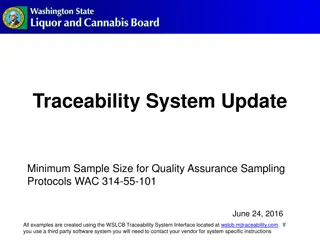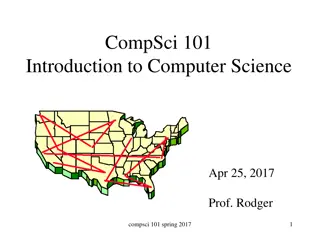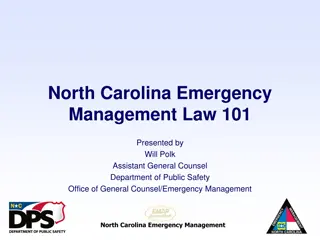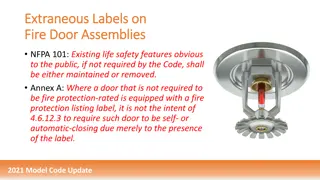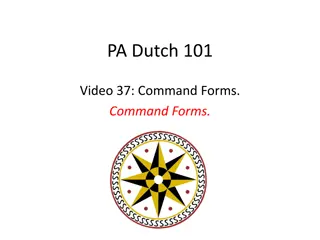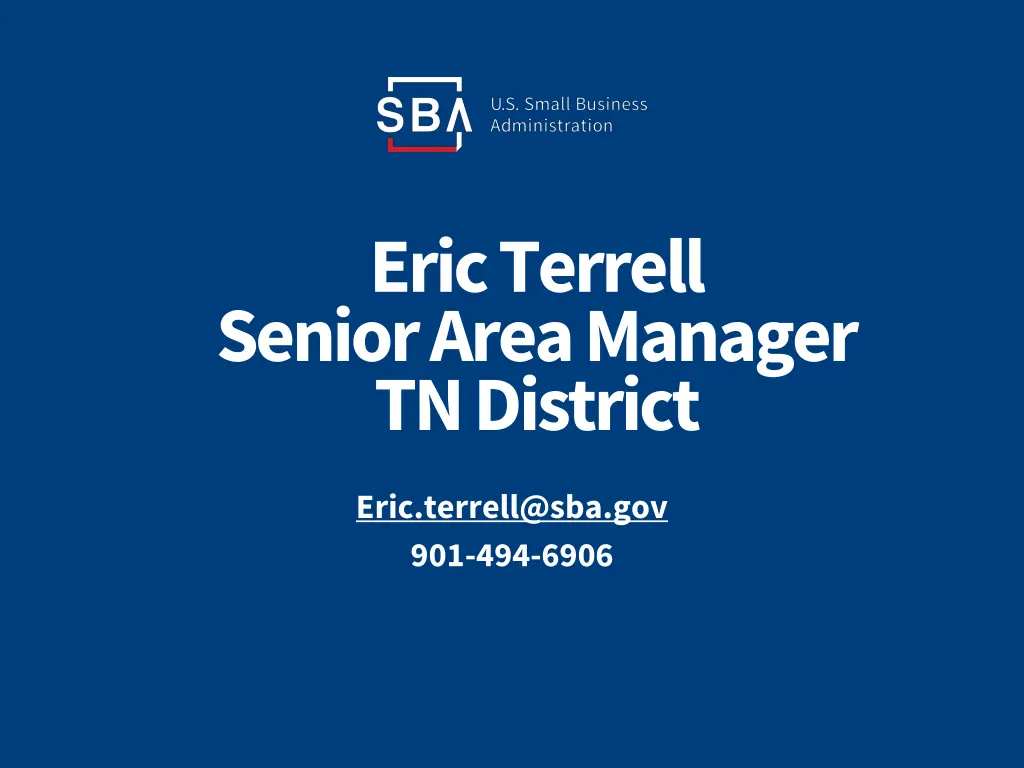
Small Business Management and Certification Programs
Learn about small business management, SDVOSB certification, and the Veteran Small Business Certification Program to help grow your business. Discover tips on legal structures, starting a small business, and understanding set-asides for different socio-economic categories.
Uploaded on | 0 Views
Download Presentation

Please find below an Image/Link to download the presentation.
The content on the website is provided AS IS for your information and personal use only. It may not be sold, licensed, or shared on other websites without obtaining consent from the author. If you encounter any issues during the download, it is possible that the publisher has removed the file from their server.
You are allowed to download the files provided on this website for personal or commercial use, subject to the condition that they are used lawfully. All files are the property of their respective owners.
The content on the website is provided AS IS for your information and personal use only. It may not be sold, licensed, or shared on other websites without obtaining consent from the author.
E N D
Presentation Transcript
Eric Terrell Senior Area Manager TN District Eric.terrell@sba.gov 901-494-6906
Veteran Small Business Certification Program (VetCert)
Set-Aside for Certification Programs and Socio-Economic Categories Targeted acquisition goals: Women-Owned Small Businesses (including EDWOSB) (5%) Overall Small Business 23% Small Disadvantaged Businesses (including 8(a)) (5%) HUBZone Businesses (3%) Service-Disabled Veteran-Owned Small Businesses (3%) Set-asides are reserved for small business between $10,000 (Micro purchase Threshold) to $250,000 (Simplified Acquisition Threshold)
Is the SDVOSB Certification Appropriate for You? 51 % ownership requirements Manage daily operations Highest officer position Proper NAICS codes Managerial experience 4
America is a Nation of Small Businesses Nationally, there are approximately 31 million small businesses. Over three- quarters of small businesses have no employees. 31 Million Small Businesses: SMALL BUSINESSES: Make up 99% of U.S. employer firms Create 65% of the net new private sector jobs Employ 47% of private-sector workforce Include 98% of the firms exporting goods
Choose Your Business Legal Structure The business structure you choose influences everything from day-to-day operations, to taxes, to how much of your personal assets are at risk. You should choose a business structure that gives you the right balance of legal protections and benefits. To begin, organize your business into some form of entity. The most common business structure entities are: Sole Proprietorship General or Limited Partnership Corporation (S Corp or C Corp) Limited Liability Company (LLC) There are advantages and disadvantages to each form of organization, so choose carefully! Consulting with business counselors, attorneys and accountants can prove helpful. 6
10 Steps to Starting a Small Business 1. Define your product or service 2. Competitive advantages and disadvantages 3. Create your marketing strategy 4. Calculate your startup costs 5. Choose your business legal structure 6. Properly set up business entity 7. Prepare yourself financially 8. Develop your strategic plan 9. Sustain your business 10. Seek professional financial assistance
Getting the Most Out of the SDVOSB Program Enables firms to qualify for set-aside or sole source contract awards helping agencies to meet their SDVOSB goals Facilitates development opportunities and increases growth potential by establishing Joint Ventures or a Mentor- Prot g agreement More prime and subcontracting opportunities through registration at Vetbiz.gov 8
10 Common Pitfalls to Avoid when Starting a Small Business 1. Lack of Planning 2. Poor Credit 3. Failure to Seek Expert Help 4. Lack of Support 5. Lack of Industry Experience 6. Labor Alignment with Business Goals 7. Insufficient Capital 8.Poor Customer Service 9. Poor Cash Management 10. Marketing and Technology Challenges
Are You Ready to Be an Entrepreneur? 1. What do I want from this business? 2. What steps have I taken to be an entrepreneur? 3. What am I willing to invest? 4. Am I willing to risk my money and time? 5. Is this a hobby? 6. Do I have an exit strategy?
From the Administrator Goal: Increase the VOSB and SDVOSB industrial base Objectives: Simplify the preparation and submission of certification documentation and data Streamline the certification review process without compromising due diligence Shift resourcesand funding from certification activities to training and growth activities The program is a top priority for SBA Administrator Isabella Casillas Guzman to ensure that veteran and service-disabled veteran business owners receive their certification and have access to the federal marketplace. VOSB = Veteran-Owned Small Business SDVOSB = Service-Disabled Veteran-Owned Small Business 11
Veteran Small Business Certification Program The National Defense Authorization Act of 2021 officially requires VA's CVE responsibilities to be transferred to the SBA as of Jan 1, 2023, and for the SBA to establish a government-wide certification program. The SBA program name for certifying VOSBs and SDVOSBs is the Veteran Small Business Certification Program, or VetCert. The final rule for the program was published on November 29, 2022, in the Federal Register. The program launched to the public and began accepting new applications on January 9, 2023. Veterans.certify.sba.gov 12
Highlights of the New SBA Certification Program Along with the transfer to the SBA, there are changes to both the process and system to receive certification and make it easier for owners to have someone assist them in preparing their application. After the grace period expires for SDVOSBs, all VOSBs and SDVOSBs will be expected to be certified by the SBA to receive sole source or set aside awards from federal agencies. Agencies will continue to receive SDVOSB goaling credit for awards made to self- certified SDVOSB on non-SDVOSB set aside or sole source contracts. The SBA intends to reevaluate self-certification for goaling purposes once this program is launched. The SBA VetCert program provides reciprocal certification for businesses with remaining eligibility in the WOSB and 8a programs. Business-friendly approach to ownership requirements that aligns veteran certifications with the 8a and WOSB programs. Joint ventures do not require certification although the managing partner must be SBA certified and the joint venture must request designation. 13
Policy Highlights Key Changes SDVOSBs need to be certified by the SBA to receive sole-source or set aside contracts from any federal agency SDVOSB government-wide goal is still 3% Agencies can still rely on self-certification for goaling purposes VOSBs continue to need to be certified for sole-source and set aside contracts from the VA under its Vets First Authority Other federal agencies do not have a mandate or authority to award contracts to VOSBs The SBA has both the certification system (for small businesses to apply/reapply) and the search tool (for the public & acquisition professionals) SAM.gov will not accurately reflect SDVOSB/VOSB certification status WOSB and 8(a) firms will have their certifications recognized if the qualifying individual(s) are the same across programs 14
Policy Highlights Key Changes (cont.) One Year Extension - Companies that were verified by the VA Center for Verification and Evaluation (VA CVE) prior to January 1, 2023, have automatically received a 1- year extension to their program term (4 years vs. 3 years) One Year Grace Period - Companies may self-certify through 2023, but must also submit an application to SBA for a final determination Certification will not be for a specific NAICS code - SBA s certification process determines that a business is currently small in at least one NAICS code listed in the firm s SAM.gov profile. To avoid restricting a certified VOSB/SDVOSB s ability to expand its operations into new industries, a firm must only qualify under the size standard corresponding to the NAICS code assigned to a specific contract. Final Rule takes steps to harmonize & simplify definitions of ownership, control, day to day operations, and standard hours across certification programs OHA handles appeals & protests Surplus Property Program is opened to VOSB & SDVOSB businesses 15
Benefits of SBA Certification The SBA provides small businesses the opportunity to access resources such as training, business counseling, access to capital, and more. Most resources such as counseling, training, classes, financial readiness assessments, etc., are offered at little to no cost to all small businesses. Certification allows firms the opportunity to compete in the federal marketplace and for sole-source and set-aside contracts. Self-certified firms do not qualify for VA contracting opportunities. 16
Eligibility To apply for certification as a VOSB or SDVOSB, a firm must meet the following requirements: Owners identified by Veteran Affairs as a veteran and or service-disabled veteran Be considered a small business as defined by the size standard corresponding to any NAICS code listed in the business s SAM profile (SAM registration required). No less than 51 percent of the business owned and controlled by one or more veterans. For certification as a SDVOSB, no less than 51 percent owned and controlled by one or more service-disabled veterans. For those veterans who are permanently and totally disabled and unable to manage the daily business operations, the spouse or permanent caregiver qualifies. 17
One-Year Certification Extension For businesses currently verified by the VA: Administrator Isabella Casillas Guzman has granted a one-time, one- year extension to current VOSBs and SDVOSBs verified by the VA. The extension allows the SBA to process applications from new entrants into the program and grow the base of certified firms. The additional year is added to the existing eligibility period of a current participant. For new applicants: New applicants certified by the SBA after January 1, 2023, will receive the standard three-year certification period. 18
Grace Period for Self-Certified Businesses The 2021 National Defense Authorization Act (NDAA) of 2021 grants a one-year grace period for self-certified SDVOSBs until January 1, 2024. During the grace period, self-certified businesses have one year to file an application for SDVOSB certification and may continue to rely on their self- certification to compete for non-VA SDVOSB set-aside contracts. Self-certified SDVOSBs that apply before the expiration of the one-year grace period will maintain eligibility until the SBA makes a final eligibility decision. 19
Transfer of VA Verified Businesses to SBA The transfer of VA verification to the SBA requires nothing from the business owner. The SBA is accepting all businesses verified by the VA as SBA-certified. All documents and data were transferred via data transfer so that those documents reside in the new SBA system. Business owners should verify that the email address used to register a VetCert account is the same email address used in their prior CVE verification. If it is different, contact VetCert Customer Service, 1-800- 862-8088. 20
What Does This Mean for VOSBs and SDVOSBs? If you are a VOSB or SDVOSB that is VA CVE verified as of the January 1, 2023, transfer date: The SBA has granted a one-time, one-year certification extension as of the transfer date for firms verified by the VA prior to January 1, 2023. The one-year extension is reflected in the SBA Veteran Small Business search tool. If the business applies for and receives recertification during the extension period, their new three-year certification begins from the date of expiration. For all verified businesses, as your verification expiration date approaches, you can apply for re-certification through the SBA s new certification program. Recertification for all VOSBs or SDVOSBs with a currently active certification will not be an option until a later date in 2023. The one-year certification extension serves to mitigate the need for recertification until the option becomes available in the new SBA application program. The SBA will actively communicate when the recertification option becomes available. 21
Does the Transfer Affect VAs Veterans First Authority? There is no effect on VA s Veterans First contracting authority. VA will continue to implement this policy utilizing the SBA s certification program and database for verification purposes as of January 1, 2023. There is no government-wide VOSB program, but the VA will retain its unique authority to award set asides and sole source VA contracts to VOSBs. VA s database of verified firms will also transfer to the SBA, who will own and maintain the database. VA contracting officers will use the SBA s database to confirm a firm s eligibility when awarding VA SDVOSB or VOSB set aside and sole source contracts. For all other agencies, SDVOSBs will need to be certified by the SBA to be eligible for set aside and sole source awards. 22
How Does a Business Prepare for Application? Step 1: Determine eligibility. The business owner must be a veteran or a service-disabled veteran as established in Title 38 CFR Part 74 or 13 CFR Part 128. Be considered a small business as defined by the size standard corresponding to at least one NAICS code listed in the business s SAM.gov profile. No less than 51 percent of the business must be owned and controlled by one or more veterans. For certification as a SDVOSB, no less than 51 percent of the business must be owned and controlled by one or more veterans rated as service-disabled by VA. For those veterans who are permanently and totally disabled and unable to manage the daily business operations of their business, their business may still qualify for certification as an SDVOSB if their spouse or appointed permanent caregiver is assisting in that management. Step 2: Ensure registration in SAM.gov. The business MUST be registered in SAM.gov to move forward. Step 3: Gather required documentation before beginning the application. A fact sheet listing required documentation is available at sba.gov/vetcert. 23
SBA Certification Process Flow Application Submission Intake Assessment Decision Intake Analyst validates basic eligibility requirements Intake Analyst requests sent to Veterans any documents that need to be sent prior to application phase Veteran creates application and uploads required business documents Owners upload required personal documents and sign VA Form 0877 Federal Reviewer reviews final case documents. Federal Reviewer makes final recommendation to approve or deny the application. Reviews and signs the final determination letter Level One Analyst Confirms receipt of all required documents; requests clarifying information as needed reviews entire application to assess regulatory compliance Level 2 Analyst reviews complex case fact patterns initiates deficiency process as needed All Analysts submit recommendation to approve, deny, or remove application Less documentation required then previous process New software easy to navigate Allows for reciprocal qualification with other SBA qualifying set aside programs. 24
SBA's Veteran Small Business Certification Program Landing Page to Login or Register a New Account Veterans.certify.sba.gov 25
For More Information Visit SBA s website: www.sba.gov/vetcert Email vetcert@sba.gov Contact the dedicated toll-free call center: 800-862-8088 Monday -Friday, 8 a.m. 6 p.m. ET Excludes federal holidays Visit theFrequently Asked Questions on the VetCert platform Veterans.certify.sba.gov 26

